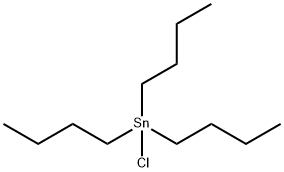A3224912
Dibutyltin dichloride , Analysis standard , 683-18-1
Synonym(s):
Dibutyldichlorostannane, Dibutyldichlorotin;Dibutyldichlorotin;Dibutyltin dichloride
CAS NO.:683-18-1
Empirical Formula: C8H18Cl2Sn
Molecular Weight: 303.84
MDL number: MFCD00000518
EINECS: 211-670-0
Update time: 2022-07-08
PRODUCT Properties
| Melting point: | 39 °C |
| Boiling point: | 135 °C10 mm Hg(lit.) |
| Density | 1.4 |
| vapor pressure | 0.0016 hPa (25 °C) |
| refractive index | 1.4991 |
| Flash point: | >230 °F |
| storage temp. | Store below +30°C. |
| solubility | 0.32g/l |
| form | Crystalline |
| color | White |
| Specific Gravity | 1.36 |
| Water Solubility | 320 mg/L, hydrolises in hot water |
| Sensitive | Moisture Sensitive |
| BRN | 3535484 |
| Exposure limits | ACGIH: TWA 0.1 mg/m3; STEL 0.2 mg/m3 (Skin) NIOSH: IDLH 25 mg/m3; TWA 0.1 mg/m3 |
| CAS DataBase Reference | 683-18-1(CAS DataBase Reference) |
| NIST Chemistry Reference | Di-n-butyltindichloride(683-18-1) |
| EPA Substance Registry System | Dibutyltin dichloride (683-18-1) |
Description and Uses
Dibutyltin dichloride is used as an organotin intermediate. It serves as heat and light stabilizer for polyvinyl chloride plastics. It is also used in the preparation of methyl 2-(methoxycarbonylmethyl)-5-iodobenzene by reacting with 2,5-diiodobenzoic acid. It acts as an esterification catalyst and a veterinary vermicide and tapeworm remedy. Further, it is used as ion exchange agent, process regulators and processing aids.
Safety
| Symbol(GHS) |     GHS05,GHS06,GHS08,GHS09 |
| Signal word | Danger |
| Hazard statements | H301-H312-H314-H317-H330-H341-H360FD-H370-H372-H410 |
| Precautionary statements | P260-P273-P280-P303+P361+P353-P304+P340+P310-P305+P351+P338 |
| Hazard Codes | T,N,C,T+ |
| Risk Statements | 25-34-51/53-63-23/24/25-68-50/53-48/25-26-21-61-60 |
| Safety Statements | 26-36/37/39-45-61-38-28A-60-53 |
| RIDADR | UN 2928 6.1/PG 2 |
| WGK Germany | 3 |
| RTECS | WH7100000 |
| F | 10-21 |
| TSCA | Yes |
| HazardClass | 6.1 |
| PackingGroup | II |
| HS Code | 29310095 |
| Hazardous Substances Data | 683-18-1(Hazardous Substances Data) |
| Toxicity | LD50 orally in Rabbit: 50 mg/kg |




